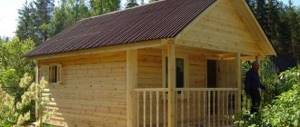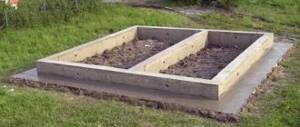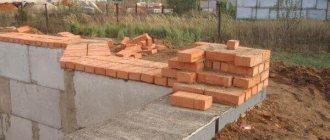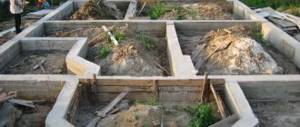Loading…
Loading…
If you are planning to build a small house, bathhouse, garage or other light-weight buildings, then know that there is no point in overpaying for the foundation. It would be much more correct to use a columnar foundation as an option for an inexpensive but durable foundation. The main thing is to approach construction issues correctly, choose the right option, and comply with technological standards and design features.
Conditions for installing a support-column structure for a future home
The use of strip concrete foundations carries an impressive financial burden on the total estimated cost of construction. The installation of a support-column foundation allows you to save money.
Its construction is possible under certain conditions:
- The calculated resistance of the soil foundation (R0) must be equal to or less than that of the point support. This will prevent the house from sagging under its own weight.
- It is advisable to install poles on rocky, coarse soils. Such a foundation is not built on heaving and swampy soils.
- The heel of the point support must be below or above the groundwater level.
- The foundation material must withstand the load and have a safety margin of + 10%.
- The bottom of the foundation should be below the freezing depth of the soil.
Assessment of soil bearing capacity
Before proceeding with the design of the foundation, it is necessary to examine the conditions and physical characteristics of the soil to a depth of at least 2 meters from the surface . You can do this yourself by taking soil samples using a hand auger.
To avoid making mistakes in assessing soil characteristics, you can order a soil analysis from a geological exploration service. Another option is to contact your local land management department for a copy of the vertical survey linked to the construction site.
Marking and purpose of concrete
To understand what proportions you need for pouring concrete, decide on the brand. Concrete of different grades is used for different purposes. The designation indicates the calculated compressive strength. This can be an indicator from M-75 to M-1000. The higher the number, the higher the strength.
- M-100 and 150 are used for pillows under the foundation,
- M-200 is used for pouring foundations, floors, paths, etc.
- M-350 is suitable for monolithic foundations, load-bearing structures, and roads.
- M-400 and 450 are suitable for the construction of hydraulic structures.
- M-500 and higher are intended for special objects (metro, dams, etc.).
Accordingly, to calculate the proportions for pouring the foundation, floor, pillars or yard, focus on the most popular brand of concrete M-200.
Types of materials used
To begin the construction of a columnar foundation foundation, you need to make the right choice of materials from which the supports will be created. The solution to this issue must be approached based on the above conditions and the type of structure.
Commonly used:
- tree;
- brick;
- asbestos and metal pipes;
- foundation blocks;
- monolithic reinforced concrete.
Tree
Support posts are made from logs (pieces of logs) or timber.
This base is suitable for light buildings such as bathhouse sheds, gazebos , etc. Wooden posts are cleaned of bark and impregnated with antiseptics.
The part of the wood that will be immersed in the soil is coated with bitumen compounds, and roofing felt is placed at the bottom of the hole.
Brick
For the construction of light frame and wooden houses on dense soil, a brick columnar foundation is erected. For this, red, rarely silicate, brick is used .
This option is acceptable for shallow foundations. The columns are laid out in the form of a square in plan with sides 1.5 bricks wide.
2-4 pieces of reinforcement are placed in the central hole of the masonry for subsequent connection with the grillage. Then the opening is filled with concrete.
Asbestos and metal pipes
Concrete pipes are structures with high load-bearing capacity . The metal or asbestos shell is both formwork and part of the foundation.
For the support-column base, pipes with a wall thickness of at least 4 mm are used. Pipes filled with concrete have proven themselves well when constructing foundations in loose soil.
Supports made of steel pipes are susceptible to corrosion, so they are primed and coated with anti-corrosion coating compounds. The underground part of the pipes is subjected to especially careful treatment with mastics.
Foundation blocks
These structures are designed for heavy loads and can be safely used as columnar foundations.
The only drawback is that the blocks cannot be accurately calculated for the load from the house , and this leads to unnecessary costs, which can significantly increase the total cost of construction.
However, in comparison with monolithic supports, there is no need to delay construction for 30 days until the load-bearing capacity of the concrete poured into the formwork is fully achieved.
Monolithic reinforced concrete
This is a classic version of a columnar foundation. It is installed, as a rule, for private houses with a height of 2 floors . Formwork is placed in the pits, into which the frame is immersed.
The structure is then filled with liquid concrete. After 30 days, the supports reach the required level of load-bearing capacity acceptable to continue construction.
Influence of foundation depth
The correct structure of a columnar foundation can be shallow or recessed. A shallow foundation is considered the most affordable because it requires a minimum investment of money. It is used on clayey, rocky and other soils of high density. At the time of arrangement, a depression of 60-70 cm is dug in the ground, where 10-20 cm is filled with sand in the form of a pillow.
Experts recommend pouring concrete in the form of a first, preparatory layer, up to 10 cm in size. For reasons of economy and expediency, M100 grade concrete is used here.
After hardening, the cushion is built and only then the main pillar of the future foundation is poured.
For unstable soils, as well as for soil that freezes to a depth of more than a meter, a buried foundation is suitable. Its depth can reach two meters, which may be required by the project after geological exploration of the area.
Construction technology (with photo)
The classic version of a support-column base is supports made of monolithic reinforced concrete. Arrangement of the foundation of the house consists of the following stages:
- Design and calculations.
- Marking.
- Excavation.
- Construction of a sand and gravel cushion.
- Manufacturing and installation of reinforced frames.
- Installation of formwork.
- Pouring concrete.
- Waterproofing.
- Installation of grillage.
Design and calculations
Preparatory work consists of the steps described below:
Determination of total load
At the design stage of a house, a specification of building materials and structures is created , where their weight is indicated.
To calculate the load on the ground from a construction site, in addition to the total mass of the building, the weight of the internal contents is taken into account - this is equipment (boiler, pipelines, air conditioning system, furniture, etc.).
The snow load on the roof is also taken into account.
Having collected the necessary data, calculate the reference area of the building using the formula: S≥ KNF/RO, where:
- S – total support area;
- F – full load from housing construction;
- KN—safety factor 1.2;
- RO – calculated soil resistance.
Distance between pillars
Based on the total supporting area, calculated soil resistance and the size of the pillar heel, the number of point foundations is calculated.
The distance between the pillars is determined by their location on the plan in the corners of the building, at the intersection points of walls and places where heavy equipment is installed.
The remaining gaps are evenly filled with the remaining supports in accordance with their calculated number.
Depth
The level of laying the support-column foundation is determined according to the depth of soil freezing at the building site. This parameter is requested from your local land surveying and architecture office .
Also, the level of freezing is determined by experimental drilling at a construction site in winter. The corresponding tables are in SNiP 01/23/99. For example, if this indicator is 1.9 m, then the laying depth should be 1.9 - 2 m.
Marking
The position of the point supports is marked according to the house plan. For this use:
- roulette,
- cord,
- benchmarks in the form of wooden pegs, slats or pieces of reinforcement.
If you don’t have your own laser level, you can rent one.
The building plot is marked as follows:
- the land is cleared of vegetation and debris, the fertile layer of soil is removed;
- benchmarks are driven into the ground sequentially, starting from one of the corners of the plan;
- The correctness of right angles is checked by measuring the diagonals of a rectangle or square of the building plan with a cord;
- mark the points of intersection of the walls;
- the remaining supports are placed at intervals of 1.5 - 2 m.
Excavation and sand and gravel bed
The holes are dug with an entrenching tool to a level below the freezing level of the soil by 150 - 200 mm. The bottom of the pits is covered with a layer of sand and gravel mixture. The formed pillows are spilled with water to compact them, and then thoroughly compacted.
After this, the level of all pillows is checked using a laser level and a rod . Discrepancies are corrected by adding or removing sand. Geotextiles are laid on the bottom, its edges are brought up to the height of the heel of the columnar support. The film is attached to the walls of the pit with ordinary nails.
In loose soils, the walls of the pits often crumble, which nullifies the work done. To prevent this phenomenon, the side surfaces are formed at a slope with the opening narrowing downward.
Manufacturing and installation of reinforced frame
How it is produced:
- Knit meshes with cells measuring 100 x 100 mm. To do this, sections of smooth reinforcement are twisted with knitting wire.
- The mesh is installed on plastic supports. This is necessary to form a protective layer of concrete.
- For the manufacture of a vertical reinforced frame, periodic profile reinforcement ø 8 mm and knitting wire are used.
- Homemade devices are used to bend reinforcing bars. How to do this is clearly shown in the video, the link is below.
- Vertical frames are connected to horizontal meshes and lowered into pits.
- The bottom of the pits is filled with concrete to the top edge of the film.
- After 10 - 15 days, when the base plate has hardened, the formwork is installed.
Making a reinforced frame - in the video:
Formwork
The following are used as formwork elements:
- boards,
- wooden boards,
- tin,
- thin metal and thick polymer sheets.
Formwork boxes are prepared at the site. Then they are put on reinforced frames. The verticality of the fences is controlled by the level on both sides of the formwork.
To prevent lateral movement of the boxes, they are fixed with spacers. All structures must be aligned in the same horizontal plane - this is also checked using a building level.
The formwork is formed in such a way that the gap between its inner surface and the reinforcement is 15 - 20 mm . This is necessary to form a protective layer that prevents corrosion of the steel frame.
How to pour concrete correctly?
For concreting foundations, you need to use a mortar mixer. It can be rented.
If the volume of concrete work takes up more than 2 m3, then it is better to order an automixer with a concrete pump . They can be used to concrete a large number of formwork glasses during one work shift.
Concrete is poured in layers with a height of 150 - 200 mm. Each layer is compacted with an electric vibrator. Many construction companies rent this tool.
After pouring is completed, the head is covered with plastic film, passing the outlets of the fittings through the holes. This will prevent moisture evaporation and protect against precipitation.
Waterproofing
After dismantling the formwork, the surfaces of the pillars are covered with bitumen mastic . It is heated with gas burners or in a tank over a fire. There are waterproofing compounds that are brought into a liquid state with special solvents.
For more reliable protection of the supports, they are additionally covered with roofing felt. After the waterproofing has hardened, the foundations are backfilled.
How to make a grillage?
The tying of the heads (grillage) of the pillars is made from:
- metal profile (angles, T-beam or I-beam),
- reinforced concrete tape,
- for wooden houses - made of timber.
The grillage is needed to uniformly transfer the load from the building to the columnar foundation.
It is advisable to install a monolithic reinforced concrete strip for 2-story houses. The outlets of the pillar reinforcement are welded to the grillage or screwed with wire to a wooden frame.
Pouring the grillage formwork with concrete - in the video:
Construction on a concrete base
Concrete flooring is a complex and expensive structure, but its strength and long service life make concrete the most popular base for a wooden floor. When laying logs on concrete, you will not need cabinets for the logs, but they will have to be isolated from each other, otherwise this will lead to the formation of moisture, which will lead to damage to the wood.
Isolation is performed in several ways:
- Laying insulating materials. It does not carry any disadvantages and perfectly preserves wood from rotting.
- Logs can be impregnated with special solutions that prevent rotting processes. This method is really good, and the expensive impregnation will not be inferior to the previous method, but there is one drawback - such treatment negates the environmental component of your floor.
- The gap between the joists and the floor will prevent rotting of the wood, thanks to good ventilation. Construction while maintaining a gap is much more difficult, but the result is worth the effort. If you decide to maintain a gap, you can use metal corners for this. Using this method, you will slightly reduce the load-bearing characteristics of the floor.
Algorithm for building on a concrete screed:
- Marking. To make markings on a concrete screed, you can use a special rope that is dipped in paint, but you can also use improvised means. A rope soaked in paint is attached to the concrete at both ends, after which it is pulled back and abruptly released. This will “punch” a straight line on the concrete.
- Next you need to drill holes for the mounting angles. This can be done with a pobedit drill and a drill.
- As in the case of logs on a wooden base, secure two logs to opposite walls, screwing them to the corners, after which you can tighten the thread and adjust the horizontal position to install all the logs.
Installing joists using corners is one of the most common solutions. Despite the fact that this method somewhat reduces the strength of the floor, builders recommend laying logs on a concrete screed in this way, because it has a lot of advantages:
- You completely prevent rotting processes caused by contact between concrete and wood.
- To secure the logs in this way, you do not need to pour a clean concrete screed, because all the unevenness of the rough screed (up to several centimeters) will be hidden thanks to the metal fastening corners. Without making a clean screed, you save a lot of time, because it will take a lot of time to dry it, in addition, you will not have to spend money on the solution.
If you decide to lay logs directly on concrete using waterproofing materials, then they should be secured with anchors or also with fastening angles.
Strengthening the foundation
Over time, the owner of the house construction may notice signs of subsidence of the columnar foundation. This can manifest itself in the form of cracks in the walls, subsidence of floors inside the house and other violations of the integrity of building structures.
To prevent the destruction of the building, it is necessary to carry out work to strengthen the pillars . There are two ways to increase the bearing capacity of the foundation.
Option 1
Identify a sagging pole. Place a jack under the heel and support it. A certain volume of soil is removed from under it. The resulting voids are filled with concrete. After 30 days the jack is removed.
Option 2
The sagging supports are supported with jacks, and additional pillars are installed between them . After the concrete has hardened and the formwork has been dismantled, the jacks are removed. To monitor foundation subsidence, beacons are installed on the supports.
If, as a result of the above measures, subsidence of the foundation of the house continues, then you need to contact a specialized service for a professional examination of the condition of the foundation and identify the causes of these negative phenomena.
Base for a wooden floor on joists
The joists can be laid on various bases made of wood or concrete, they can also be attached to the walls, additionally installing support pillars under the joists to give greater strength to the floor. Each option has technological features, which we will discuss below. When choosing one of these methods, you should pay attention to the operational purpose of the room in which you are building the floor, for example, if the floor in this room will bear heavy loads, then it is better to use a concrete base for a wooden floor.
Possible mistakes and how to avoid them
The most common mistakes during the construction of columnar foundations are:
- the calculation of the bearing capacity of the support is incorrect;
- violation of the verticality of the pillars;
- incorrect calculation of the number of pillars, the size of the supporting area;
- poorly executed waterproofing;
- carrying out work in winter;
- use of low quality materials.
Information on the Internet or advice from experienced builders will help you avoid mistakes when erecting pillars. If you still have doubts, it is better not to engage in construction yourself, but to turn to professionals.
You will find a lot of important and useful information about columnar foundations here.
Calculation of materials and preparation
Work on the construction of supports for laying logs begins with the preparation of the underground:
- Using a tape measure, determine the location of future brick pedestals and drive in control pegs.
- If the length of the floorboards exceeds 4 meters, a reinforced concrete base is made.
- Reinforcement with a diameter of 5-8 mm is cut into segments along the length of the concrete base. The underground soil is thoroughly compacted. Mounting brackets are prepared in advance.
- Floor joists 10x15 or 15x15 cm are impregnated with an antiseptic and dried.
- A mesh of twine with a cell of 1.5 * 1.5 meters is made level and at an angle of 90 degrees for visual control of the height of the supports being erected, and it is fixed to the upper edge of the foundation.
- Materials are calculated depending on the number and height of the racks. As a rule, 1 row of support consists of 4 bricks, and the pitch of the supports for the logs is 1.5-2 meters. The bricks are counted individually, and then the volume of cement and sand required for masonry is determined based on a 1:2 ratio.
- To improve the waterproofing of joists and floors, expanded clay of a fraction of 1.5-2 cm is used. Its quantity is determined based on the layer height of 10-12 cm per underground area.
What is it: concept and device, photo
A columnar foundation is a system of pillars buried in the ground, which can be fastened with a grillage or subfloor of the building.
Pillar supports are installed in those places under the building where the foundation will bear increased load:
- at the corners of the building;
- at the intersection of walls;
- along load-bearing walls.
A set of pillars united into a single structure, subject to proper design and high-quality installation, is not subject to deformation, overturning or displacement of individual elements.
The following are built on foundations of this type:
- frame and wooden cottages,
- as well as baths,
- garages,
- terraces,
- temporary buildings,
- summer kitchens.
A full-fledged house can also be built on supports, but in this case you need more pillars with a large cross-sectional area.
This construction option is used in areas with rocky or frozen soil . In areas with high groundwater levels, where it is very difficult to build a strip foundation, a columnar foundation is used, with the supports being dug to a depth below the ground flow level.
Types of foundation supports
There are several ways to make vertical supports.
The type of construction and the nature of the soil determine the choice of columnar foundation and the type of columns used. These elements can be of different configurations of sections and sizes: with round, rectangular, square bases. The materials described have a reinforced concrete internal structure. According to the manufacturing method, foundation structures are:
- Monolithic type. A well is dug in the soil, formwork is installed, and the prepared concrete mixture is poured.
- Prefabricated type. The components of the supports are blocks, bricks, and special types of stones.
Location of the column foundation above the soil level:
- Unrecessed base. The support is placed directly on the soil or in a layer of sand. It is low-budget, but can be used for lightweight buildings with one floor, which are located on weak and stationary soils.
- Recessed foundation. During installation, the supports are immersed to a depth up to or above the soil freezing level. This type of construction is used on mobile loamy or clay soil. The most expensive installation of a pillar foundation.
- Shallow base. The depth of laying elements is 0.4–0.7 m from the ground level. One part of the base is a monolithic structure of a certain configuration, the second is a sand-crushed stone layer. Used on non-clayey soil or with a low content of such a substance.
In the construction of small lightweight structures, it is not necessary to use fastening beams.
Based on the type of construction, foundations on concrete pillars are:
- With beam for fastening. The grillage structure is mounted on supports, evenly distributing the mass of the entire building along the bases of the columns.
- Without mounting beam. This is a common option for arranging lightweight buildings. The first connection is installed on a support on top of the hydraulic barrier.
Advantages and disadvantages
Pillar foundations, designed for the construction of frame buildings without basements, are distinguished by an adequate price, ease of implementation, and lack of pressure on the ground. There are quite a few advantages to this type of foundation:
- you can design it yourself without resorting to the services of specialists;
- can be installed on different types of soil (with the exception of areas with heaving processes);
- can be located on slopes;
- no need to pre-level the landscape;
- construction in a short time - about two weeks from scratch;
- durability (service life up to fifty years);
- no expensive waterproofing, low final price.
This video shows how to build a columnar foundation:
But there are two main disadvantages. Firstly, foundations on pillars are not suitable for multi-story buildings or heavy brick buildings. Secondly, basements are excluded.
Brick support structure
Let's look at the instructions on how to properly make a columnar foundation using bricks or blocks:
- Roofing felt is spread on the walls of the wells; one of its features is good waterproofing.
- A structure made of reinforcement is installed over the entire depth of the pit. It should not be higher than ground level.
- Next, a concrete solution is poured into which gravel or crushed stone is added.
- As a result, the well must be completely filled with concrete. The concrete setting process lasts up to 10 days.
- Several layers of roofing material are laid on the surface of the concrete base, which will serve as good waterproofing for subsequent masonry.
This is the technology for constructing a columnar foundation; it is much more economical in its design. You can do it yourself.
Differences in installing a columnar foundation for a bathhouse and a house
However, you should not save money and lay this type of foundation for the construction of heavy brick or block structures of houses, and especially cottages with several floors. Such a building could be torn apart at any moment. Even screw piles are not always able to withstand excessively high loads.
Currently, the columnar-strip type of foundation, which is able to withstand the extremely large weight of the structure, is very popular. The depth of the supports in this case is located below the freezing level, and the pillars are connected from above with tape. However, it is almost impossible to build such a combined foundation on your own, without the use of special equipment. In addition, the cost of materials will be rather high. After pouring such a base, further construction work can be carried out no earlier than a month later - this period is necessary for the cement to completely harden.
Installation of formwork
Let's look at how to make semicircular formwork yourself. To cope with the task, you will need a detailed and drawn up project, as well as fundamental skills in construction.
For rings
How to make round formwork for a well with your own hands? Such a system, by its definition, is a type of form that is used in the construction of wells. Particularly popular among private owners is the option of a sliding formwork structure.
To prepare the formwork for concrete rings, we will need sheets of metal whose thickness does not exceed two millimeters. We take the length of the inner strip to be 2.6 m, the outer – 2.86 m. The height will be standard, like the sheet itself – 1 m.
From the parameters of the steel sheet it is clear that the structure will be solid. Note that summer residents often stop at 1.5 m for the outer diameter and 1.3 m for the inner diameter. In this case, the sheets are selected to be one and a half millimeters thick and 0.62 m high, which significantly lightens the weight of the structure.
Such parameters are considered satisfactory because it is possible to produce a solid reinforced concrete pipe, so that rings are not even required. Holes for five bolts are drilled at the ends of each strip.
Having built such formwork for concrete rings, you can dig and equip a well yourself.
For the foundation
Rounded foundations are poured by many today. Private owners try to carry out such work on their own, since everything turns out to be quite simple.
First of all, the construction site is prepared for laying the foundation. A layer of plant soil is removed, and the points at which the trench will be prepared are determined.
Having finished with the markings, they choose the formwork option and determine the dimensions and material for its manufacture. A solid frame is created from individual elements, the upper edge of which is aligned with the general slope of the site.
The main feature of round formwork is the choice of the right material, which will combine flexibility and the required strength. If large loads are not expected on the foundation under construction, then an excellent option would be plastic formwork, which can be easily given the required shape.
If formwork is made of wood, then its base is strengthened with pegs, and the joints are coated with mortar as an additional measure. Special jumpers are used to connect the elements.
Plywood material resembles plastic in its characteristics, but is less bendable. Such formwork cannot withstand significant loads.
The best option for round formwork is metal. Due to its weight and strength, it is somewhat more difficult to work with; joints are made by welding or using self-tapping screws.
Round formwork tanks are most often manufactured in a factory and transported to the construction site in a rolled-up state. There the sheets are unfolded and mounted in the required places.
For columns
If there are several round supports, then it is recommended to make universal formwork so that the geometric shapes of the columns do not differ
Please note that a junction with the purlin may be provided at the top, which will also have to be taken into account when installing the formwork
We design the exact dimensions of the columns and prepare in advance the materials from which the surface will be formed. If you are going to use boards, it is recommended to treat the internal surfaces with a plane.
We sew the boards together with a block. Placed transversely, it will act as a stiffener. A certain number of connected boards are assembled in the shape of a pillar. There must be a strong connection at the base, since this is where the pressure from the solution will be maximum.
A steel frame is made from twisted wire. It can also be made using a welding machine. A reinforcing base is laid in the wooden structure.
In order to easily dismantle the structure in the future, it is recommended to cover the inside surface of the shields with plastic film.











